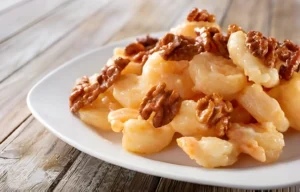Dive into the delectable world of Honey Walnut Shrimp recipe, a dish that harmoniously marries the sweetness of honey and the rich, nutty crunch of walnuts with the succulent texture of shrimp. This mouthwatering ensemble has captivated palates, earning its fame as a beloved favorite in both home kitchens and opulent restaurant menus alike.
Imagining the golden, crispy exterior of the shrimp yielding to a tender, juicy bite is enough to set your taste buds aflutter. But it’s the honey-glazed walnuts, glistening with a caramelized sheen, that elevate this dish to a level of indulgence. It’s a celestial match, where the comfort of seafood meets the indulgence of candied nuts, bathed in a creamy, sweet sauce that ties every element together in a symphony of flavors.
Originally inspired by the culinary finesse of Hong Kong cuisine, Honey Walnut Shrimp has carved its niche in the realm of fusion dishes, gaining popularity across the globe. Its appeal stretches far and wide, tugging at the heartstrings of those who relish the thought of a gourmet dish that is surprisingly simple to prepare.
Envision plating this masterpiece in your own home, the aroma wafting through the air, promising a gastronomic delight. It’s not just a recipe; it’s an experience—a feast for the senses that doesn’t require hours of slaving away in the kitchen. Indeed, the beauty of Honey Walnut Shrimp lies in its unpretentious complexity, a dish that is as enjoyable to create as it is to savor.
Essential Ingredients and Equipment
Gathering Your Ingredients
Before you embark on the culinary journey of crafting Honey Walnut Shrimp, assembling all the ingredients is essential to ensure a smooth cooking process. Here’s what you’ll need:
For the Shrimp:
1 pound large shrimp: Opt for fresh, plump shrimp, preferably peeled and deveined for convenience. Shrimp are a cornerstone of the recipe, providing a succulent, protein-rich base. If sourcing sustainability is a concern, take a cue from Made With Lau and consider shrimp from South America, known for their quality and taste.
For the Candied Walnuts:
1/2 cup white sugar: This will create the sweet, crystalline coating for the walnuts.
1 cup water: Necessary for dissolving the sugar to form a syrup.
1 cup walnuts: The hero ingredient that adds a delightful crunch and nuttiness.
For the Creamy Honey Sauce:
1/2 cup mayonnaise: This serves as the creamy binder for your sauce. Choose a good-quality mayonnaise for richness.
1/4 cup honey: The sweetness of honey balances the savory aspect of the dish. A floral, aromatic honey can add depth to the sauce.
1 tablespoon sweetened condensed milk (optional): Some recipes, like The Recipe Critic’s, include this for added sweetness and a velvety texture.
For the Shrimp Batter:
1 egg: Acts as a binder for the batter.
1/2 cup cornstarch: Gives the shrimp a light, crispy coating once fried.
Salt and white pepper to taste: These enhance the shrimp’s flavor before frying.
Assembling the Necessary Equipment
With your ingredients laid out, let’s make sure your kitchen is equipped with the right tools for the task:
Large mixing bowl: To prepare the shrimp and batter mixture.
Medium saucepan: Essential for creating the candied walnuts.
Large skillet or wok: A must-have for frying the shrimp to achieve that perfect golden crispiness.
Paper towels: Useful for draining excess oil from the fried shrimp.
Slotted spoon: Ideal for safely removing shrimp and walnuts from hot oil.
Whisk or fork: For combining the sauce ingredients thoroughly.
Measuring cups and spoons: Accuracy in measuring ensures the balance of flavors in the dish is just right.
Tips for Ingredient Preparation
As you gather your ingredients and equipment, keep these tips in mind for the best results:
Quality of Shrimp: The freshness of the shrimp is paramount. Look for bright, firm shrimp with a sea-fresh smell. Fresh shrimp should have no discoloration or strong fishy odor.
Preparing Walnuts: When creating candied walnuts, it’s crucial not to rush the caramelization process. The sugar and water mixture should reach a golden hue slowly for the best flavor.
Sauce Consistency: When mixing the honey sauce, aim for a smooth, even consistency. If the sauce is too thick, a splash of water can be added to thin it slightly without sacrificing flavor.
Temperature Control: Maintain a consistent, medium-high heat when frying the shrimp to ensure each piece cooks evenly and achieves a delightful crunch.
Ingredient Substitutions: If you have dietary restrictions or preferences, consider using alternatives such as gluten-free cornstarch or vegan mayonnaise. These substitutions can be made without significant alterations to the overall taste profile of the dish.
By meticulously selecting your ingredients and preparing them with care, you’re setting the stage for a Honey Walnut Shrimp dish that is bound to be a delectable triumph. The fresher the ingredients and the more attentive the preparation, the more pronounced and satisfying each bite will be. Now, with everything in place, you’re ready to dive into the heart of the cooking process: crafting the dish itself, where each step unfolds to reveal the magic within this beloved culinary creation.
Step-by-Step Recipe Instructions
Step-by-Step Recipe Instructions
Having assembled your ingredients and necessary equipment, it’s time to embark on the exciting journey of creating Honey Walnut Shrimp. Here, we will delve into a comprehensive guide, broken down into manageable steps, ensuring that each part of the process is easy to follow and guarantees a delightful outcome. Let’s get started.
Preparing the Candied Walnuts
Combine Sugar and Water:
In a medium saucepan, bring 1/2 cup of white sugar and 1 cup of water to a boil. Stir occasionally to ensure the sugar completely dissolves.
Add the Walnuts:
Once the sugar-water mixture reaches a rolling boil, add 1 cup of walnuts. Lower the heat and simmer for about 2 minutes. This allows the walnuts to soak up the syrup, ensuring an even coat.
Caramelize the Walnuts:
Increase the heat to medium-high and continue cooking the walnuts in the syrup. Stir frequently, watching as the mixture thickens and reduces, eventually turning into a caramelized coating on the nuts.
Cool the Walnuts:
Using a slotted spoon, carefully remove the candied walnuts from the saucepan and spread them out on a baking sheet lined with parchment paper. Let them cool completely. They should harden and become delightfully crunchy as they sit.
Making the Honey Sauce
Mix Sauce Ingredients:
In a bowl, whisk together 1/2 cup of mayonnaise, 1/4 cup of honey, and 1 tablespoon of sweetened condensed milk until smooth and well-combined. The goal is a luscious, creamy sauce with a hint of sweetness.
Adjust Consistency:
If the sauce seems too thick, add a teaspoon of water at a time until the desired consistency is achieved. It should be easily drizzled but not runny.
Preparing and Frying the Shrimp
Batter the Shrimp:
In a large mixing bowl, beat 1 egg and season with salt and white pepper. Add the 1 pound of large shrimp to the egg and toss until fully coated. Next, sprinkle in 1/2 cup of cornstarch and toss again until the shrimp are well-covered with a light dusting.
Heat the Oil:
In a large skillet or wok, heat enough oil to cover the bottom by a few inches over medium-high heat. You’ll know the oil is ready when a small amount of batter dropped into it sizzles immediately.
Fry the Shrimp:
Once the oil is hot, carefully add the battered shrimp one by one, being careful not to overcrowd the pan. Fry for about 2 minutes per side, or until golden and crispy.
Drain the Shrimp:
Remove the shrimp using a slotted spoon and transfer them to a plate lined with paper towels to drain any excess oil.
Bringing It All Together
Toss Shrimp in Sauce:
In a large bowl, gently toss the fried shrimp with the honey sauce, ensuring each piece is evenly coated. Do this while the shrimp are still warm to help the sauce cling better.
Garnish and Serve:
Arrange the honey-sauced shrimp on a platter. Generously sprinkle the candied walnuts over the top, and if desired, garnish with a sprinkle of thinly sliced green onions for color and a mild onion flavor.
Serve Immediately:
Honey Walnut Shrimp is best enjoyed fresh and hot. Serve it immediately to savor the contrast between the warm, creamy shrimp and the crunchy, sweet walnuts.
By following these meticulous steps, you’ll craft a Honey Walnut Shrimp dish that’s not only visually impressive but also a symphony of flavors and textures. As with any recipe, feel free to make it your own by adjusting the sweetness of the sauce or the level of crispiness for the shrimp. The joy of cooking comes from making a dish that suits your tastes, and with this guide, you’re well on your way to achieving just that.
Nutritional Profile of Honey Walnut Shrimp
Nutritional Profile of Honey Walnut Shrimp
Honey Walnut Shrimp, a dish that marries the sweetness of honey with the rich, nutty flavor of walnuts, all while showcasing the succulence of shrimp, is not only a feast for the senses but also presents an interesting nutritional profile. While indulging in this delicious meal, it is valuable for consumers to understand what they are eating from a nutritional standpoint.
Calories
A single serving of Honey Walnut Shrimp, which typically contains about 5 to 6 large shrimp along with candied walnuts and sauce, averages around 450 to 500 calories. The number of calories can vary depending on the ingredients used and the cooking method. For those monitoring their caloric intake, it’s worth noting that most of these calories come from the sauce and candied walnuts.
Macronutrients
Protein: Shrimp is an excellent source of lean protein. A serving of Honey Walnut Shrimp can provide approximately 20 to 25 grams of protein, which is essential for muscle repair, growth, and overall body function.
Carbohydrates: Due to the addition of sugar in candying the walnuts and honey in the sauce, the carbohydrate count for this dish can be significant. A serving may contain between 35 to 50 grams of carbohydrates. While carbohydrates are the body’s primary energy source, it’s important for diners to consume them in moderation, especially refined sugars.
Fats: The sauce and walnuts contribute to the total fat content, which can range from 20 to 30 grams per serving. The majority is unsaturated fat from the walnuts and mayonnaise, which are healthier options when consumed in controlled amounts. Unsaturated fats are known for their role in maintaining heart health and lowering cholesterol levels.
Micronutrients
Vitamins and Minerals: Shrimp offers a variety of vitamins and minerals, such as selenium, vitamin B12, and phosphorus. Walnuts add an extra boost of omega-3 fatty acids, which are beneficial for brain health and inflammation reduction.
Cholesterol: It’s noteworthy that shrimp are high in cholesterol. However, recent studies suggest that for many people, the consumption of dietary cholesterol has a limited impact on blood cholesterol levels when compared to the impact of saturated fats.
Dietary Fiber
Dietary fiber is minimal in Honey Walnut Shrimp due to the lack of fruits, vegetables, or whole grains in the standard recipe. For a more balanced meal, consider pairing the dish with a side of vegetables or brown rice.
Sugars
The honey and sugar used in both the walnut coating and the sauce contribute to the overall sugar content. Overconsumption of added sugars can lead to various health issues, such as weight gain and an increased risk of heart disease, making it prudent for consumers to enjoy this dish in moderation.
Nutritional Impact
This dish’s rich flavor and satisfying texture come at the cost of being calorie-dense, with a significant amount of sugars and fats. However, by making thoughtful adjustments, diners can mitigate these concerns. Opting for light mayonnaise or reducing the amount of honey can decrease fat and sugar content without sacrificing taste.
Additionally, the protein-rich shrimp and heart-healthy fats from walnuts make this dish a beneficial source of important nutrients. It is crucial to balance this meal with other foods lower in fats and sugars throughout the day to maintain a well-rounded diet.
Understanding the nutritional content of Honey Walnut Shrimp is vital for those who are health-conscious or have dietary restrictions. By considering the breakdown of calories, macronutrients, and micronutrients, consumers can make informed decisions that align with their nutritional needs and enjoy this delicious dish as part of a balanced diet.
Cooking Tips and Variations
Cooking Tips and Variations for Honey Walnut Shrimp
Creating the perfect Honey Walnut Shrimp dish requires not just following a recipe, but also understanding how each step and ingredient can be tweaked to achieve the best result. To that end, here are practical cooking tips and suggestions for variations that will help you customize the dish to your palate and dietary preferences.
Selecting the Right Shrimp
When choosing shrimp for your Honey Walnut Shrimp, size matters. Opt for shrimp that are labeled 26/30, which means there are 26 to 30 shrimp per pound. This size is ideal for a good bite and ensures even cooking. Always check for freshness; fresh shrimp should have a slight sea breeze aroma and a firm texture. If possible, purchase shrimp that have been sustainably sourced. The Monterey Bay Aquarium’s Seafood Watch program recommends avoiding shrimp from Argentina, China, and India due to less sustainable harvesting practices.
Achieving the Perfect Glaze
The glaze for Honey Walnut Shrimp should be creamy and stick to the shrimp without being overly heavy. To ensure this, whisk the mayonnaise, honey, and sweetened condensed milk together until you achieve a smooth consistency. Adjust the sweetness to your taste by adding honey incrementally. Before tossing in the shrimp, make sure they are well-drained and slightly cooled so the sauce adheres properly.
Candying Walnuts Without Overcooking
Candied walnuts are a star component of this dish. To candy them perfectly, dissolve sugar in water over medium heat, then add the walnuts. Watch the nuts closely as the water evaporates. They’re done when the sugar recrystallizes and forms a shiny coat around the nuts. Stir continuously to prevent burning. Remove the walnuts from the heat immediately once candied and spread them out on parchment paper to cool.
Alternative Ingredients for Dietary Restrictions
For those with dietary restrictions, there are several ways to alter this recipe without compromising on taste:
Low-Calorie Option: Use a low-fat mayonnaise or substitute with Greek yogurt to cut down on calories without sacrificing creaminess.
Gluten-Free Adaptation: Replace the regular flour with a gluten-free alternative like rice flour or a gluten-free all-purpose blend for dredging the shrimp.
Vegetarian Version: Although shrimp is the main ingredient, a vegetarian variation could include battered and fried cauliflower florets in place of shrimp, following the same steps for the sauce and walnuts.
Spice Level Adjustments
The sweetness of the honey sauce is a defining feature, but some people may prefer a bit of heat. Adding a dash of chili flakes to the sauce or a small amount of sriracha will introduce a subtle spiciness that complements the sweet and nutty flavors without overwhelming the dish.
Cooking the Shrimp to Perfection
Overcooked shrimp can become tough and rubbery. Cook the shrimp until they turn pink and opaque, which typically takes about two minutes per side. Use a high smoking point oil like vegetable or canola oil for frying to achieve a crispy exterior without any unpleasant aftertaste.
Presentation Tips
To elevate the presentation of your Honey Walnut Shrimp, consider serving it in a lettuce wrap for a refreshing crunch or on a bed of fluffy white rice to absorb the sauce. Garnish with thinly sliced green onions or a sprinkle of sesame seeds for added texture and visual appeal.
Making Ahead and Storage
Although Honey Walnut Shrimp is best served fresh, you can prepare parts of the dish in advance. The candied walnuts and sauce can be made beforehand and stored separately. Just reheat the walnuts in the oven for a few minutes to bring back the crunch and gently warm the sauce before tossing with the freshly fried shrimp.
Incorporating Vegetables
To add a nutritional boost and color to the dish, toss in some steamed broccoli or sautéed bell peppers with the shrimp and sauce. This not only adds more vitamins and fiber to your meal but also creates a more balanced dish.
With these tips and variations, making Honey Walnut Shrimp can be a fun and flexible cooking experience. By paying attention to the quality of ingredients, carefully monitoring your cooking processes, and being open to a few twists, you’ll be sure to impress with this classic dish, tailored just to your liking.



